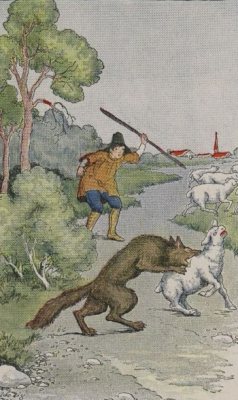
“The Boy Who Cried Wolf” is the story of a young shepherd. Growing bored with his work, he shouts “Wolf!” to make the townspeople come running. He laughs at them and at their anger when they find he has tricked them. He repeats the joke, so at last when a wolf really comes, he calls for help but they don’t come, thinking he’s playing tricks on them again.
While you can just tell this story to the class, there are other options:
- Tony Ross has done a great picture book version of the story.
- An online version is suitable for elementary school readers.
- Listen to the story at Storynory
- Find printable story cards for young children.
- The story is also included in the Evan-Moor Literature Pockets book for grades 2-3, with reproducible activities.
Once you’ve read or told the story and made certain that your class understands it, consider these cross-curricular connections (as always, these include ideas for all grades — folk and fairy tales are in the standards for our state up to 7th grade):
Character Education
- This story is usually understood to have a moral about honesty; sometimes it’s included in the story, with phrasing like “No one believes a liar, even when he tells the truth.” Ask students to rewrite or act out the story, having the shepherd boy choose to be truthful instead.
- An early English version of the story ends with a moral about keeping play separate from work: larking about and playing tricks are fine, this retelling says, but not when you’re supposed to be working. Workplaces even now often have rules about “horseplay.” Think of examples of kinds of pranks that could be dangerous or costly at work. Have students make posters illustrating and warning against unwise tricks at work.
- Watch Passenger’s music video of “The Boy Who Cried Wolf” and discuss its telling of the story. The boy in this video feels that he will never be able to live down the lies he told. Can people change their behavior and change their reputation? Should people get more chances after they’ve done something they shouldn’t? There is an animated wolf catching a sheep, so please view the video before showing it to your class.
Social Studies
- People are often accused of “crying wolf” when they give repeated warnings about things that may never come to pass. Have older students search online for political issues that have brought up accusations of crying wolf.
- The hero of this story is a boy, a child, and yet he has a job — or maybe a chore to help out his family. Explain that in other times and places, children have often worked instead of gone to school. Many people now are working toward a time when children all over the world can study instead of working to support their families. Use this idea as a writing prompt. Depending on grade level, students might write about whether they’d rather work than play, research and report on kinds of work children did in the past, or propose ways to help end child labor in our modern world.
Critical Thinking
- It’s possible to see this story as being about how boredom can cause someone to get in trouble. Ask students whether they ever have this problem. If so, brainstorm ways to cope with the problem. Rewrite the story so that the shepherd uses another approach to deal with the problem of boredom in his job.
- The shepherd’s plan A for the appearance of a wolf in this story was to call for help. When his pranks made that plan fall through, what did he have for a plan B? In some tellings of the story, he gets eaten by the wolf. Challenge students to come up with other plans for dealing with the wolf.
[amazon_link asins=’0689874332,1402755465,B078H41C7B,1846434076,014054612X’ template=’ProductCarousel’ store=’us-1′ marketplace=’US’ link_id=’2db1d4da-2bc9-11e8-93ae-3b49de4a008e’]







Pingback: Fairy Tales: Classic, Fractured, Multicultural, and Surprisingly Scientific
I think your readers would find our website super valuable as well!
We are trying to create a huge pond of reading resources, hence the name of our website:
https://readingduck.com
It’s a completely free resource, packed with content that complements what you’re sharing here.
I believe it would be a great addition to your page and something your audience would enjoy exploring.
Either way, I would love any feedback you have on our website to help us improve it.
A 1,000 Thanks,
Rebecca Simpson